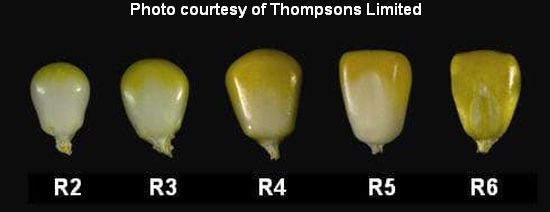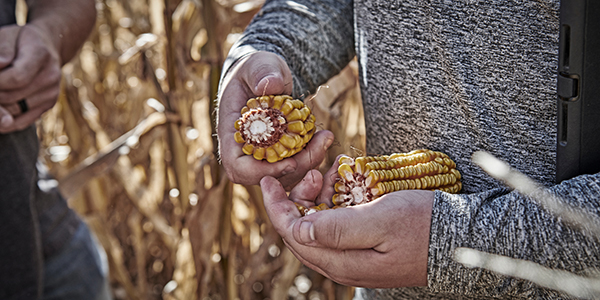AGRONOMIC RESOURCESTO SUPPORT EVERY SEASON
YOU CAN TAKETO THE FIELD
Corn Doesn't Care About the Calendar

Silking: R-1
R-1 is when 50% of the plants have silks showing out of the top of the ear. They are only viable for about five days, which is a short window to receive pollen from the corn tassels. This stage uses the most water per day, using about 1/3 inch of water per day. Dry conditions will cause the silks to slow their development and pollen shed to speed up. To get from R1 Silking to Brown Silk, it takes about 300 GDU’s, or about 15 days under normal temperatures.
Blister: R-2
At this point, the cob is white and the kernels are just a bubble on the cob with white or translucent yellow color. The kernels are about 85% water and stress at this time can cause the plant to abort kernels, starting at the tip of the ear and moving down. The plant will abort kernels until it has enough carbohydrates to finish the ear. To get from R-2 Blister to Early Milk takes about 200 GDU’s, or about 9 days with normal temperatures.
Milk: R-3
Milk stage is when the kernel is filled with a milky white liquid. The outside of the kernel is yellow and it is about 80% moisture at this point. The plant is pumping starch into the kernel and as the plant moves through this stage the kernels start to become inside. The butt end of the ear will develop first and by late milk it will contain semi solid starch. To get from Milk R-3 to Late Milk takes about 200 GDU’s or about 9 days with normal temperatures.
Dough: R-4
Dough stage happens about 25 days after silking. The inside of the kernel is a doughy, pasty like consistency and the moisture is about 70%. At this point, you might even start to see some denting at the base of the ear. Stress during R-4 will reduce Test Weight. To get from Dough R-4 to Dent takes about 200 GDU’s or 9 days with normal temperatures.
Dent: R-5
Dent stage is when most of the kernels on the ear are dented and you can cut them with a fingernail. This usually happens around 33 days after silking. The kernels have a milk line now that shows below the dented cap of the kernel. The milk line is what separates the starch from the milky liquid. At this point the kernels have about 60% moisture and stress in this stage will reduce Test Weight. In R-5 the corn is about 375 GDU’s, or about 20 days of normal temperatures, from black layer or Physiological Maturity.
Mature: R-6
A corn crop is considered mature when black layer forms. Generally, kernel moisture is around 32% at this point and combines can technically start to roll. However, growers generally wait until the moisture drops more before harvesting. Rates vary, but generally moisture will drop 0.4%-0.6% per day. Growing degree units are the driving factor when it comes to drydown. The less heat we get in September, the longer it will take to get the 200+ GDU’s required to move through the reproductive stages. If there is a frost before the corn reaches black layer on its own, the plant will create a black layer to protect the kernel and stop maturing any further, which will cause higher moisture and much lower test weight in the kernel.
To learn more about corn reproductive stages or learn more about your specific LG Seeds hybrid, contact your local Technical Team Agronomist.
References and additional information: https://www.ipm.iastate.edu/files/03%20Corn%20Growth%20and%20Development.pdf
Download a copy of this technical bulletin here: Corn Doesn't Care About the Calendar






Technical Team Agronomist